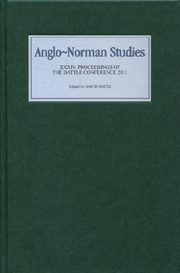Book contents
- Frontmatter
- Contents
- LIST OF ILLUSTRATIONS AND TABLES
- EDITOR'S PREFACE
- ABBREVIATIONS
- Mints and Money in Norman England
- Literate Sociability and Historical Writing in Later Twelfth-Century England
- The Archbishopric of Canterbury and the So-called Introduction of Knight-Service into England
- Lastingham and the Architecture of the Benedictine Revival in Northumbria
- ‘Lanfranc of Bec’ and Berengar of Tours
- The Invention of the Manor in Norman England
- Herbert Losinga's Trip to Rome and the Bishopric of Bury St Edmunds
- Le récit de Geoffroi Malaterra ou la légitimation de Roger, Grand Comte de Sicile
- The Two Deaths of William Longsword: Wace, William of Malmesbury, and the Norman Past
- The Beasts Who Talk on the Bayeux Embroidery: The Fables Revisited
- The Piety of Earl Godwine
The Two Deaths of William Longsword: Wace, William of Malmesbury, and the Norman Past
Published online by Cambridge University Press: 05 April 2013
- Frontmatter
- Contents
- LIST OF ILLUSTRATIONS AND TABLES
- EDITOR'S PREFACE
- ABBREVIATIONS
- Mints and Money in Norman England
- Literate Sociability and Historical Writing in Later Twelfth-Century England
- The Archbishopric of Canterbury and the So-called Introduction of Knight-Service into England
- Lastingham and the Architecture of the Benedictine Revival in Northumbria
- ‘Lanfranc of Bec’ and Berengar of Tours
- The Invention of the Manor in Norman England
- Herbert Losinga's Trip to Rome and the Bishopric of Bury St Edmunds
- Le récit de Geoffroi Malaterra ou la légitimation de Roger, Grand Comte de Sicile
- The Two Deaths of William Longsword: Wace, William of Malmesbury, and the Norman Past
- The Beasts Who Talk on the Bayeux Embroidery: The Fables Revisited
- The Piety of Earl Godwine
Summary
William Longsword, the second duke of Normandy, was a mythic figure for the generations of Normans who came after him. He was the first duke to succeed to the position, the first to be born a Christian, and an expert at manoeuvring in the difficult political environment of northern France in the tenth century. Further enhancing his reputation was the fact that he was tragically assassinated in 942, betrayed by someone supposedly offering him friendship. Thanks to this convergence of traits, in the first two hundred years after his death William Longsword almost achieved the status of a martyr saint among the monastic chroniclers in Normandy and England – quite literally, for some chroniclers infused his life story with elements of hagiographical writing. For them, William symbolized the continuation of Normandy's divinely ordained destiny. They held him up as an example for other rulers to emulate through his justice, military prowess, diplomacy, and especially his piety.
All the chroniclers in Normandy and England, that is, except for two. William of Malmesbury and Wace told a very different story of the life and death of William Longsword. According to them, the second duke of Normandy was not such a saint: his death was not a treacherous assassination but justified retaliation for his own villainy. Through this second version of the death of William Longsword, these two authors questioned the divine destiny of the Norman dynasty.
- Type
- Chapter
- Information
- Anglo-Norman Studies 34Proceedings of the Battle Conference 2011, pp. 193 - 208Publisher: Boydell & BrewerPrint publication year: 2012

